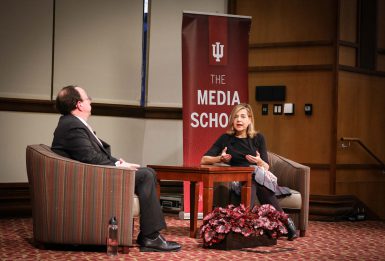Washington Post’s Margaret Sullivan discusses press’s relationship with the public

The 2016 presidential election brought threats against the media and accusations of “fake news” by then-candidate and now-President Donald Trump. Margaret Sullivan, media columnist for The Washington Post, said Tuesday that this rhetoric undermines the press’s freedom, which is a cornerstone of U.S. democracy.
“I think this undermining hurts us globally, because for many years the United States has been a beacon of press freedom and of free speech, particularly in countries that don’t have it or have only a tenuous grasp on that,” she said at The Media School’s final fall Speaker Series in a talk titled, “The Public’s Complicated Relationship with the Press.”
“When that has been harmed the way I think it has been harmed through rhetoric, we’ve lost something real,” she added.
The talk was presented by The Media School, the Center for International Media Law and Policy Studies and the Barbara Restle Press Law Project. Media School associate professor and CIMLAPS director Anthony Fargo co-led the discussion. Their first topic was the threats Trump has made to alter media legislation, such as changing libel laws and revoking broadcast licenses.
“It was a little bit unnerving to hear the president of the United States directly threatening media organizations,” Fargo said.
Although Trump has yet to attempt to change or present any new laws regarding the media, Sullivan said his rhetoric around the topic still matters. The United Stated needs a free press to serve as a watchdog of the government. Other countries need a free press to serve as an example as well, Sullivan said.
But as media columnist, Sullivan said she has spoken with many Americans who are not happy with the press. Some have told her they specifically voted for Trump because of his distaste for the news media. Fargo offered an explanation.
“One criticism I’ve heard particularly in this part of the country toward the media related to the last election is that there was a disconnect that had always been there, but perhaps became more pronounced,” he said.
The perceived disconnect is between the attitudes, opinions and concerns of people and news media in population hubs along the coasts and those living in the country’s interior. Sullivan said she doesn’t think the news media fully understood the anger, resentment and economic anxiety the interior of the country was feeling.
“It’s not that we didn’t go to Wisconsin. It’s not that we didn’t go to Iowa — and I’m talking about the mainstream press as a whole — we tended to kind of go to do some brief coverage and leave,” Sullivan said. “We weren’t really a part of the fabric of things, and this is something that needs to be corrected.”
Scientists and IU emeriti professors Pat Foster and Andrew Hanson were in the audience. They found what Sullivan said interesting, but not surprising. They saw their media consumption habits change after the election, and they become more skeptical of the news media.
“It’s great to have members of the current press talk to a media school,” Foster said. “She has seen a lot of different stages of the press, and has a lot of insights.
Sullivan cited a poll that found 46 percent of its respondents think the news media fabricates stories about the president. At the mainstream, “reality-based press,” she said, journalists aren’t making stories up. Those who do and those who plagiarize find themselves kicked out of the industry pretty quickly. When journalists do make mistakes, the vast majority work hard to correct them and get it right next time.
“I really wish that the public knew how seriously we take our jobs and how, at least at the places I’ve been, people feel like they … are actually doing a public service, and they take accuracy very seriously, and they take getting it right and being fair very seriously,” Sullivan said.
Sullivan said more transparency may ease the tension between the press and the public. She said organizations tend to get good responses when journalists take the time to write about how they reported on a story. When she was the public editor at The New York Times, there was a great deal of interest in the process, and the audience appreciated having the curtain pulled back.
Before joining the Post, Sullivan was the first female public editor of The New York Times and the first female editor at The Buffalo (New York) News. She said her career may not have been possible without the help she received as a young journalist.
“I certainly got a lot of help coming up,” she said, speaking to the student journalists in the room. “I do, and I think every journalist I know, wants to sort of pay that forward, so I wouldn’t hesitate to ask for the help and to take advantage of that.”
More:

